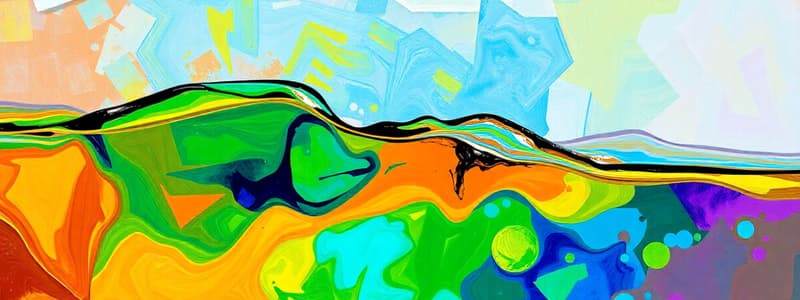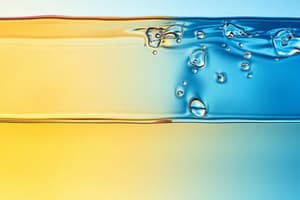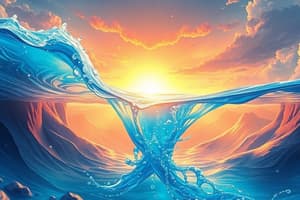Podcast
Questions and Answers
What percentage of Earth's surface is currently covered in water?
What percentage of Earth's surface is currently covered in water?
- 71% (correct)
- 81%
- 61%
- 91%
Which phase of water is the least abundant on Earth?
Which phase of water is the least abundant on Earth?
- Liquid
- Solid
- Freshwater (correct)
- Gas
What is the primary location of Earth's freshwater resources?
What is the primary location of Earth's freshwater resources?
- In rivers and lakes
- In soil moisture
- In the atmosphere
- In groundwater (correct)
What percentage of water in most adult bodies is made up of water?
What percentage of water in most adult bodies is made up of water?
Which organ in the human body contains the highest percentage of water?
Which organ in the human body contains the highest percentage of water?
What is the main component of water as a molecule?
What is the main component of water as a molecule?
Which method is NOT used for making non-drinkable water usable?
Which method is NOT used for making non-drinkable water usable?
What fraction of Earth's freshwater is found in glaciers and ice caps?
What fraction of Earth's freshwater is found in glaciers and ice caps?
What is the primary characteristic of dipole-dipole attraction?
What is the primary characteristic of dipole-dipole attraction?
Which of the following statements best defines hydrogen bonding?
Which of the following statements best defines hydrogen bonding?
What role do electronegative atoms play in molecular interactions?
What role do electronegative atoms play in molecular interactions?
In which scenarios do strong hydrogen bonds primarily form?
In which scenarios do strong hydrogen bonds primarily form?
What phase states can water naturally occur in on Earth?
What phase states can water naturally occur in on Earth?
Which of the following describes the effects of hydrogen bonding on water's behavior?
Which of the following describes the effects of hydrogen bonding on water's behavior?
What minimizes repulsion between molecules during hydrogen bonding?
What minimizes repulsion between molecules during hydrogen bonding?
What is a key feature of molecules that exhibit dipole-dipole attractions?
What is a key feature of molecules that exhibit dipole-dipole attractions?
What percentage of Canada's surface area is covered by lakes and rivers?
What percentage of Canada's surface area is covered by lakes and rivers?
Which concept describes the bonding within a water molecule?
Which concept describes the bonding within a water molecule?
How much of the global fresh surface water is contained in the Great Lakes?
How much of the global fresh surface water is contained in the Great Lakes?
What fraction of Canadians rely on groundwater for drinking water?
What fraction of Canadians rely on groundwater for drinking water?
What type of bonding occurs between atoms within a water molecule?
What type of bonding occurs between atoms within a water molecule?
Which term refers to the interactions between multiple water molecules?
Which term refers to the interactions between multiple water molecules?
What is the main type of interaction that keeps water molecules together?
What is the main type of interaction that keeps water molecules together?
What does the term 'phase changes' refer to in the context of water?
What does the term 'phase changes' refer to in the context of water?
What remains intact when water changes its physical state?
What remains intact when water changes its physical state?
Which statement best describes the nature of water molecules?
Which statement best describes the nature of water molecules?
How does the presence of intermolecular forces affect physical state changes in water?
How does the presence of intermolecular forces affect physical state changes in water?
What is the charge of the oxygen atom in a water molecule?
What is the charge of the oxygen atom in a water molecule?
What does the term 'dipole' refer to in the context of water?
What does the term 'dipole' refer to in the context of water?
In dipole-dipole attraction, what interactions are maximized?
In dipole-dipole attraction, what interactions are maximized?
Which aspect of water's molecular structure contributes to its polarity?
Which aspect of water's molecular structure contributes to its polarity?
What is the representation for a partially positive charge in water molecules?
What is the representation for a partially positive charge in water molecules?
Flashcards
Water's Importance
Water's Importance
Water is essential for all life on Earth, comprises 71% of Earth's surface, and exists in various forms like rivers, lakes, glaciers, groundwater, and the atmosphere.
Water's States
Water's States
Water exists as a solid (ice), liquid (water), and gas (water vapor) naturally on Earth.
Molecule
Molecule
A molecule is two or more atoms bonded together.
Freshwater
Freshwater
Signup and view all the flashcards
Groundwater
Groundwater
Signup and view all the flashcards
Surface Water
Surface Water
Signup and view all the flashcards
Physical States
Physical States
Signup and view all the flashcards
Water's Percentage in Humans
Water's Percentage in Humans
Signup and view all the flashcards
Covalent Bond
Covalent Bond
Signup and view all the flashcards
Intramolecular Bonding
Intramolecular Bonding
Signup and view all the flashcards
Intermolecular Forces
Intermolecular Forces
Signup and view all the flashcards
Hydrogen Bonding
Hydrogen Bonding
Signup and view all the flashcards
What is the percentage of surface area covered by Canadian lakes and rivers?
What is the percentage of surface area covered by Canadian lakes and rivers?
Signup and view all the flashcards
What percentage of global fresh surface water do the Great Lakes contain?
What percentage of global fresh surface water do the Great Lakes contain?
Signup and view all the flashcards
What changes in water's state?
What changes in water's state?
Signup and view all the flashcards
Why is water polar?
Why is water polar?
Signup and view all the flashcards
What does 'δ-' mean?
What does 'δ-' mean?
Signup and view all the flashcards
What is a dipole?
What is a dipole?
Signup and view all the flashcards
Dipole-Dipole Attraction
Dipole-Dipole Attraction
Signup and view all the flashcards
What is 'PARTIALLY POSITIVE'?
What is 'PARTIALLY POSITIVE'?
Signup and view all the flashcards
What is 'PARTIALLY NEGATIVE'?
What is 'PARTIALLY NEGATIVE'?
Signup and view all the flashcards
Why are electrons important for polarity?
Why are electrons important for polarity?
Signup and view all the flashcards
Electronegativity
Electronegativity
Signup and view all the flashcards
What makes hydrogen bonding strong?
What makes hydrogen bonding strong?
Signup and view all the flashcards
How does hydrogen bonding affect water?
How does hydrogen bonding affect water?
Signup and view all the flashcards
Why is water unique?
Why is water unique?
Signup and view all the flashcards
What are the three phases of water?
What are the three phases of water?
Signup and view all the flashcards
What is the importance of hydrogen bonding to water's unique properties?
What is the importance of hydrogen bonding to water's unique properties?
Signup and view all the flashcards
Study Notes
Water: Background
- Water is essential for all life on Earth
- 71% of Earth's surface is covered by water
- Oceans hold 96.5% of Earth's water
- Remaining water exists as: freshwater in rivers and lakes, frozen water in glaciers and ice caps, soil moisture, groundwater aquifers, and water vapor in the atmosphere
Water: Background (Phases)
- Water occurs naturally as a solid, liquid, or gas (three phases/physical states)
- Currently, water exists as a solid (ice, snow), liquid (rain, surface water, groundwater), and gas (water vapor, humidity)
- Surface water is found on top of land (e.g., streams, rivers, lakes, wetlands)
- Groundwater is located beneath Earth's surface, in rock and soil pore spaces and fractures
- Seawater is water from a sea or ocean
Water: Background (Definitions)
- A molecule is two or more atoms bonded together.
- Water (H₂O) is a molecule composed of three atoms bonded together.
- Water exists in three physical states: solid (ice), liquid (water), and gas (water vapor).
- Aqueous solutions are dissolved in water.
Water: Some Numbers
-
Humans are primarily composed of water
-
Newborn babies are about 78% water
-
One-year-old infants are about 65% water
-
Adults are 55-60% water (fat contains less water than muscle)
-
Water percentage in organs:
- Lungs: 83%
- Kidneys: 79%
- Brain: 73%
- Heart: 73%
-
Water percentage in the body decreases with age
Water: Some Numbers (Geology)
- Freshwater: less than 1,000 milligrams per liter of dissolved solids (mostly salt)
- Less than 3% of Earth's water is freshwater
- Freshwater sources:
- Glaciers/ice caps: >68%
- Groundwater: ~30%
- Surface water: ~0.3%
- Most accessible drinking water comes from 0.3% of 3% of Earth's water
Water: Some Numbers (Canada)
- Canada has abundant freshwater resources
- About 20% of the world's surface water is in Canada
- Canada's lakes and rivers cover 12% of the surface area
- Canada has more "lake area" than any other country
- The Great Lakes contain 18% of global fresh surface water
- 25% of Canadians depend on groundwater for drinking water
Water: Essential Concepts
-
Intermolecular Forces (Hydrogen Bonding)*
-
Intermolecular forces are important interactions between molecules.
-
Hydrogen bonding is a type of intermolecular force that is stronger than other dipole-dipole interactions.
-
Hydrogen bonds occur when hydrogen is bonded to a highly electronegative atom (oxygen, nitrogen, or fluorine).
Water: Phase Changes
- Three phases of water: solid, liquid, and gas
- Phase changes occur between these states, like melting, freezing, evaporation, condensation, sublimation, and deposition.
- When a substance changes state, the molecules remain intact, but the intermolecular forces change, not the molecules themselves.
Water: Phase Changes (Density)
- Ice is less dense than liquid water
Studying That Suits You
Use AI to generate personalized quizzes and flashcards to suit your learning preferences.
Related Documents
Description
Explore the fundamental importance of water for life on Earth, its distribution across the planet, and its various phases as solid, liquid, and gas. Understand the different forms of water found in nature, including surface water, groundwater, and seawater. This quiz covers the essential definitions and characteristics of water.




